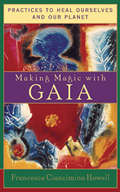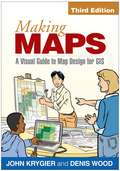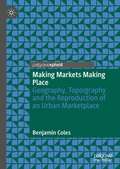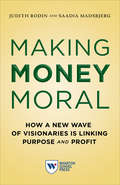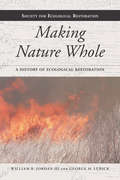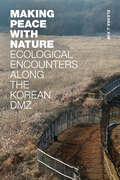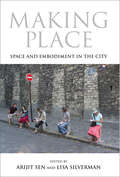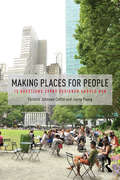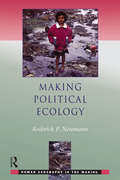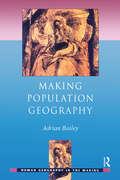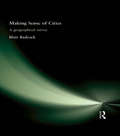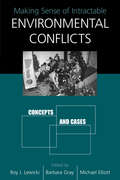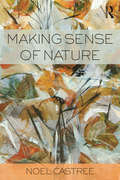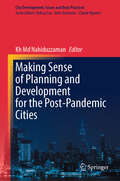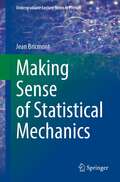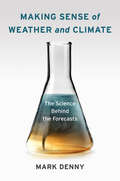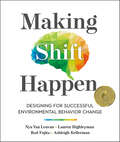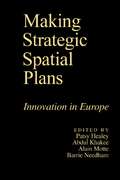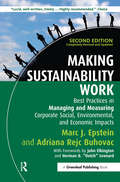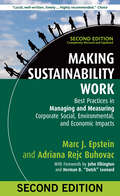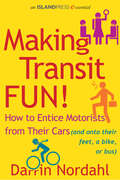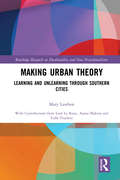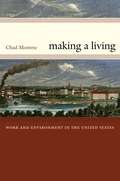- Table View
- List View
Making Magic with Gaia: Practices to Heal Ourselves and Our Planet
by Francesca Ciancimino HowellThe author of Food, Festival and Religion shows how spiritual practices drawn from the ancient magical arts can help to heal Mother Earth. A Greenpeace activist, Wiccan High Priestess, and proud Soccer Mom, Francesca Howell has been involved in magical traditions and wildlife preservation since childhood. In this one-of-a-kind book, she shares her everyday suggestions for spiritual renewal through connecting with nature. The meditations, ceremonies, and spellcraft in Making Magic with Gaia spring from an ancient Pagan tradition of Earth stewardship, which blends deep ecology, magic, and activism to bring the reader into a closer communion and harmony with Mother Earth. Packed with practical suggestions (recycling, gardening without pesticides, and conserving water) and mystical rituals (shamanism, crystal magic, and Power Animals) for helping the planet, this book is written for anyone with a spiritual ecological awareness. Not the witchcraft of Gothic novels, Making Magic with Gaia is based on a modern religion with ancient roots that can heal the Earth as it heals the practitioner.
Making Maps: A Visual Guide to Map Design for GIS
by Denis Wood John KrygierAll components of map making are covered: titles, labels, legends, visual hierarchy, font selection, how to turn phenomena into visual data, data organization, symbolization, and more. Innovative pedagogical features include a short graphic novella, good design/poor design map examples, end-of-chapter suggestions for further reading, and an annotated map examplar that runs throughout the book.
Making Markets Making Place: Geography, Topo/graphy and the Reproduction of an Urban Marketplace
by Benjamin ColesThis book examines place and place-making in London’s Borough Market. In particular, it uses topo/graphy (‘place-writing) to interrogate the ways in which Borough Market’s material, social-sensual and discursive relations assemble to reproduce Borough Market as a place, market and marketplace. Its central premise is that market-processes – the negotiation and exchange of commodities –are place-processes. This means that the often-abstract relationships that ultimately define what we think of as the economy are embedded in the rich and every materiality, sociality, sensuality and meanings associated with place. By tracing out these different elements, topo/graphy illustrates the ways in which economic reproduction is grounded in particular and often discrete practices. However, by assembling them together, this highlights the ways in which place and place-making are the driving force behind the economy at large.
Making Money Moral: How a New Wave of Visionaries Is Linking Purpose and Profit
by Judith Rodin Saadia Madsbjerg“As we look ahead to the recovery from the COVID-19 crisis, Making Money Moral could not come at a better time.”—Jamie Dimon, Chairman and Chief Executive Officer, JPMorgan ChaseThe math doesn’t add up: Global financial markets can no longer ignore the world’s most critical problems. The risks are too high and the costs too great.In Making Money Moral: How a New Wave of Visionaries Is Linking Purpose and Profit, authors Judith Rodin and Saadia Madsbjerg explore a burgeoning movement of bold and ambitious innovators. These trailblazers are unlocking private-sector investments in new ways to solve global problems, from environmental challenges to social issues such as poverty and inequality. They are earning great returns and reimagining capitalism in the process. Pioneers in the field of sustainable and impact investing, Rodin and Madsbjerg offer first-hand stories of how investors of every type and in every asset class are investing in world-changing solutions—with great success. Meet the visionaries who are leading this movement:The investment managers putting trillions of dollars to work, like TPG, Wellington Management, State Street Global Advisors, Nuveen, Amundi, APG and Natixis;The asset owners driving the transition, like GPIF and PensionDanmark;A new generation of entrepreneurs benefiting from the investments, like DreamBox Learning, an innovative educational technology platform, and Goodlife Pharmacies, which is disrupting the traditional notion of a pharmacy; The corporations that are repurposing their business models to meet demand for sustainable products and services, like Ørsted; andThe nonprofits that are reimagining how to raise money for their work while creating significant value for investors, like The Nature Conservancy.In their book, Rodin and Madsbjerg offer a deep look at the most powerful tools available today—and how they can be unlocked. They reveal:Who the investors are and what they want;How innovative products and investment strategies can deliver long-term value for investors while improving lives and protecting ecosystems;How leaders can build strategies and prepare their organizations to enter and expand this dynamic market; andHow to measure impact, understand critical regulations, and avoid potential pitfalls.A roadmap to making the financial market a force for good, Making Money Moral is a must-read for those seeking private-sector capital to address a big problem, as well as those seeking both to mitigate risk and to invest in big solutions.“Judith Rodin and Saadia Madsbjerg identify an important new way of looking at money: from the root of all evil to the fount of all solutions. Their timely, important book on impact investing is full of powerful insights and compelling examples they’ve seen firsthand. Their work will be sure to accelerate momentum toward a more sustainable world.”—Rosabeth Moss Kanter, Harvard Business School Professor and Author of Think Outside the Building: How Advanced Leaders Can Change the World One Smart Innovation at a Time
Making Nature Whole: A History of Ecological Restoration (Science Practice Ecological Restoration)
by William R. Jordan III George M. LubickMaking Nature Whole is a seminal volume that presents an in-depth history of the field of ecological restoration as it has developed in the United States over the last three decades. The authors draw from both published and unpublished sources, including archival materials and oral histories from early practitioners, to explore the development of the field and its importance to environmental management as well as to the larger environmental movement and our understanding of the world. Making Nature Whole is a landmark contribution, providing context and history regarding a distinctive form of land management and giving readers a fascinating overview of the development of the field. It is essential reading for anyone interested in understanding where ecological restoration came from or where it might be going.
Making Peace with Nature: Ecological Encounters along the Korean DMZ
by Eleana J. KimThe Korean Demilitarized Zone (DMZ) has been off-limits to human habitation for nearly seventy years, and in that time, biodiverse forms of life have flourished in and around the DMZ as beneficiaries of an unresolved war. In Making Peace with Nature Eleana J. Kim shows how a closer examination of the DMZ in South Korea reveals that the area’s biodiversity is inseparable from scientific practices and geopolitical, capitalist, and ecological dynamics. Drawing on ethnographic fieldwork with ecologists, scientists, and local residents, Kim focuses on irrigation ponds, migratory bird flyways, and land mines in the South Korean DMZ area, demonstrating how human and nonhuman ecologies interact and transform in spaces defined by war and militarization. In so doing, Kim reframes peace away from a human-oriented political or economic peace and toward a more-than-human, biological peace. Such a peace recognizes the reality of war while pointing to potential forms of human and nonhuman relations.
Making Place: Space And Embodiment In The City
by Arijit Sen Lisa SilvermanSpace and place have become central to analysis of culture and history in the humanities and social sciences. Making Place examines how people engage the material and social worlds of the urban environment via the rhythms of everyday life and how bodily responses are implicated in the making and experiencing of place. The contributors introduce the concept of spatial ethnography, a new methodological approach that incorporates both material and abstract perspectives in the study of people and place, and encourages consideration of the various levels--from the personal to the planetary--at which spatial change occurs. The book's case studies come from Costa Rica, Colombia, India, Austria, Italy, the United Kingdom, and the United States.
Making Places for People: 12 Questions Every Designer Should Ask
by Jenny Young Christie Johnson Coffin** Honorable Mention at the 2019 ERDA Great Places Awards ** Making Places for People explores twelve social questions in environmental design. Authors Christie Johnson Coffin and Jenny Young bring perspectives from practice and teaching to challenge assumptions about how places meet human needs. The book reveals deeper complexities in addressing basic questions, such as: What is the story of this place? What logic orders it? How big is it? How sustainable is it? Providing an overview of a growing body of knowledge about people and places, Making Places for People stimulates curiosity and further discussion. The authors argue that critical understanding of the relationships between people and their built environments can inspire designs that better contribute to health, human performance, and social equity—bringing meaning and delight to people’s lives.
Making Places for People: 12 Questions Every Designer Should Ask
by Jenny Young Christie Johnson CoffinMaking Places for People explores 12 social questions crucial to environmental design. Authors Christie Johnson Coffin and Jenny Young bring perspectives from practice and teaching to challenge assumptions about how places meet human needs. In this expanded second edition, the authors continue to explore the complexities of basic questions, such as: What is the story of this place? What logic orders it? How big is it? How sustainable is it? They consider the impact on making places of pandemic, climate change, human migration, and contemporary discussions of diversity, equity, and justice. Short, approachable, easy-to-read chapters, illustrated with updated examples of projects from around the world, bring together theory, methodology and key research findings. Understanding experienced and research-based connections between people and built form can inspire designs that make places of meaning and delight. This second edition will be essential reading for design students and professionals.
Making Political Ecology (Human Geography in the Making)
by Rod NeumannMaking Political Ecology presents a comprehensive view of an important new field in human geography and interdisciplinary studies of nature-society relations. Tracing the development of political ecology from its origins in geography and ecological anthropology in the 1970s, to its current status as an established field, the book investigates how late twentieth-century developments in social and ecological theories are brought together to create a powerful framework for comprehending environmental problems.Making Political Ecology argues for an inclusionary conceptualization of the field, which absorbs empirical studies from urban, rural, First World and Third World contexts and the theoretical insights of feminism, poststructuralism, neo-Marxism and non-equilibrium ecology. Throughout the book, excerpts from the writings of key figures in political ecology provide an empirical grounding for abstract theoretical concepts.Making Political Ecology will convince readers of political ecology's particular suitability for grappling with the most difficult questions concerning social justice, environmental change and human relationships with nature.
Making Population Geography (Human Geography in the Making)
by Adrian BaileyMaking Population Geography is a lively account of the intellectual history of population geography, arguing that, while population geography may drift in and out of fashion, it must continue to supplement its demographic approach with a renewed emphasis on cultural and political accounts of compelling population topics, such as HIV-AIDS, sex trafficking, teen pregnancy, citizenship and global ageing, in order for it to shed light on contemporary society. Making Population Geography draws both on the writings of those like Wilbur Zelinsky and Pat Gober who were at the very epicentre of spatial science in the 1960s and those like Michael Brown and Yvonne Underhill-Sem whose post-punk introspections of method, content and purpose, now push the field in new directions. Using a wide range of case studies, contemporary examples and current research, the book links the rise and fall of the key concepts in population geography to the changing social and economic context and to geographys turn towards social theory. Referencing the authors classroom experiences both in the US and the UK, Making Population Geography will appeal to students studying geography, population issues and the development of critical scholarship.
Making Sense of Cities: A geographical survey (A\hodder Arnold Publication)
by Blair BadcockIn 2000, for the first time, a majority of the world's population was living in cities. The trend towards increasing urbanization shows no sign of slowing and the third millennium looks set to be an unprecedentedly urban one.'Making Sense of Cities' provides an up-to-date, vibrant and accessible introduction to urban geography. It offers students a sense of the patterns and processess of urbanization and the spatial organisation of cities, recognizing the significance of globalization, economics, politics and culture from a range of perspectives. Above all, it seeks to provide a relevant approach, inviting students to engage with competing theories of the urban and to assess them against the background of their own opinions and personal experience.Examples and case studies are drawn from a range of international settings, from San Francisco to Shanghai, Sydney to Singapore, giving a genuinely global coverage. The book is written in a fresh and engaging stlye, and is fully illustrated throughout. It is designed to appeal to any student of the urban and will be essential to students of geography, urban studies, town planning and land economy.
Making Sense of Intractable Environmental Conflicts: Concepts And Cases
by Barbara Gray Roy Lewicki Michael ElliottDespite a vast amount of effort and expertise devoted to them, many environmental conflicts have remained mired in controversy, stubbornly defying resolution. Why can some environmental problems be resolved in one locale but remain contentious in another, often carrying on for decades? What is it about certain issues or the people involved that make a conflict seemingly insoluble?Making Sense of Intractable Environmental Conflicts addresses those and related questions, examining what researchers and experts in the field characterize as "intractable" disputes--intense disputes that persist over long periods of time and cannot be resolved through consensus-building efforts or by administrative, legal, or political means. The approach focuses on the "frames" parties use to define and enact the dispute--the lenses through which they interpret and understand the conflict and critical conflict dynamics.Through analysis of interviews, news media coverage, meeting transcripts, and archival data, the contributors to the book examine the concept of framing and the role that it plays in conflicts; outline the essential characteristics of intractability and its major causes; offer case studies of eight intractable environmental conflicts; present a rich body of original interview material from affected parties; and set forth recommendations for intervention that can help resolve disputes.Within each case chapter, the authors describe the historical development and fundamental nature of the conflict and then analyze the case from the perspective of the key frames that are integral to understanding the dynamics of the dispute. They also offer cross-case analyses of related conflicts. Conflicts examined include those over natural resource use, toxic pollutants, water quality, and growth.
Making Sense of Nature
by Noel CastreeWe listen to a cacophony of voices instructing us how to think and feel about nature, including our own bodies. The news media, wildlife documentaries, science magazines, and environmental NGOs are among those clamouring for our attention. But are we empowered by all this knowledge or is our dependence on various communities allowing our thoughts, sentiments and activities to be unduly governed by others? Making Sense of Nature shows that what we call ‘nature’ is made sense of for us in ways that make it central to social order, social change and social dissent. By utilising insights and extended examples from anthropology, cultural studies, human geography, philosophy, politics, sociology, science studies, this interdisciplinary text asks whether we can better make sense of nature for ourselves, and thus participate more meaningfully in momentous decisions about the future of life – human and non-human – on the planet. This book shows how ‘nature’ can be made sense of without presuming its naturalness. The challenge is not so much to rid ourselves of the idea of nature and its ‘collateral concepts’ (such as genes) but instead, we need to be more alert to how, why and with what effects ideas about ‘nature’ get fashioned and deployed in specific situations. Among other things, the book deals with science and scientists, the mass media and journalists, ecotourism, literature and cinema, environmentalists, advertising and big business. This innovative text contains numerous case studies and examples from daily life to put theory and subject matter into context, as well as study tasks, a glossary and suggested further reading. The case studies cover a range of topics, range from forestry in Canada and Guinea, to bestiality in Washington State, to how human genetics is reported in Western newspapers, to participatory science experiments in the UK. Making Sense of Nature will empower readers from a wide range of fields across the social sciences, humanities and physical sciences.
Making Sense of Planning and Development for the Post-Pandemic Cities (City Development: Issues and Best Practices)
by Kh Md NahiduzzamanThis book holds a distinguished promise of an intellectual understanding and complete account of that shifts in laying out resilient planning, development, and policy landscapes for the cities to come. The approach offers a unique perspective on planning and development in the post-pandemic era, addressing the interconnectedness of diverse spatial, social, cultural, economic, demographic, and political aspects. It provides insights into the transformational behavior of cities and citizens, explores the influence of remote work on the real estate market, emphasizes the need for resilient infrastructure and adaptive planning, and reinforces the association between health infrastructure and planning for resilient cities. The book provides a comprehensive account of the shifts and challenges faced in planning and development due to climate change and the COVID-19 pandemic. It explores transformational urban planning, sociocultural, and economic landscapes and addresses topics, including land use changes, transformational real estate market, urban recreational space, adaptive infrastructure, and the need for resilient planning. It offers valuable insights for urban designers, architects, geographers, city planners, policymakers, and pubic officials seeking to enhance city resilience in the post-pandemic era. The intended readership of the book includes urban designers, architects, city planners, geographers, policy makers, and public officials. It caters to individuals interested in gaining a critical understanding of the interconnectedness between various spatial, social, cultural, economic, demographic, and political aspects. The content level is academic, offering scholarly insights and a unique post-pandemic perspective on enhancing city resilience.
Making Sense of Statistical Mechanics (Undergraduate Lecture Notes in Physics)
by Jean BricmontMany people, including physicists, are confused about what the Second Law of thermodynamics really means, about how it relates to the arrow of time, and about whether it can be derived from classical mechanics. They also wonder what entropy really is: Is it all about information? But, if so, then, what is its relation to fluxes of heat?One might ask similar questions about probabilities: Do they express subjective judgments by us, humans, or do they reflect facts about the world, i.e. frequencies. And what notion of probability is used in the natural sciences, in particular statistical mechanics?This book addresses all of these questions in the clear and pedagogical style for which the author is known. Although valuable as accompaniment to an undergraduate course on statistical mechanics or thermodynamics, it is not a standard course book. Instead it addresses both the essentials and the many subtle questions that are usually brushed under the carpet in such courses. As one of the most lucid accounts of the above questions, it provides enlightening reading for all those seeking answers, including students, lecturers, researchers and philosophers of science.
Making Sense of Weather and Climate: The Science Behind the Forecasts
by Mark DennyHow do meteorologists design forecasts for the next day's, the next week's, or the next month's weather? Are some forecasts more likely to be accurate than others, and why? Making Sense of Weather and Climate takes readers through key topics in atmospheric physics and presents a cogent view of how weather relates to climate, particularly climate-change science. It is the perfect book for amateur meteorologists and weather enthusiasts, and for anyone whose livelihood depends on navigating the weather's twists and turns. Making Sense of Weather and Climate begins by explaining the essential mechanics and characteristics of this fascinating science. The noted physics author Mark Denny also defines the crucial differences between weather and climate, and then develops from this basic knowledge a sophisticated yet clear portrait of their relation. Throughout, Denny elaborates on the role of weather forecasting in guiding politics and other aspects of human civilization. He also follows forecasting's effect on the economy. Denny's exploration of the science and history of a phenomenon we have long tried to master makes this book a unique companion for anyone who wants a complete picture of the environment's individual, societal, and planetary impact.
Making Shift Happen: Designing for Successful Environmental Behavior Change
by Nya Van Leuvan Lauren Highleyman Rod Fujita Ashleigh KellermanNautilus Book Award Winner: An “engagingly written” behavioral science-based guide to tackling our urgent environmental problems (Robert B. Cialdini, author of Influence: The Psychology of Persuasion).To create a sustainable future and achieve positive, durable change, we must design solutions based directly on how people think, make decisions, and act. From hotels that save water (and money) using simple signage to energy suppliers that boost participation in renewable energy programs through mere enrollment-form tweaks, it’s clear that shifting the behavior of millions for the better is possible.Based on decades of research into what drives behavior change, Making Shift Happen provides a suite of powerful tools to transform the world. It features A-to-Z guidance on how to design a behavior change initiative—from choosing the right audience and uncovering what drives their behavior to designing, prototyping, testing, and implementation. Clear instructions and real-world examples empower you to apply hundreds of behavioral science solutions including:Using social norms to spread positive environmental behaviorsSelecting and testing stories, metaphors, and values to frame information for each audienceCatalyzing action by aligning your initiative with your audience’s personal and social motivatorsBreaking bad habits and building positive onesCapturing your audience’s attention and reducing barriers to actionConnecting people with nature and building empathy for the environment and its inhabitantsMaking Shift Happen is a must-have guide for practitioners in non-profits, governments, and businesses looking to design successful campaigns and initiatives that shift behaviors and mindsets toward positive environmental outcomes and a better future for all.“Completely fascinating—we’ve learned a lot about the ways minds work in the last decades and that may help us figure out how to appeal to our better angels more effectively than in the past. Rest assured that people who want to sell us junk are paying attention to these insights—the rest of us better do so too!” —Bill McKibben, author of The End of Nature
Making Space: Property Development and Urban Planning (An\arnold Publication Ser.)
by Andrew MacLaranMaking Space studies the built environment by examining the private-sector forces responsible for its development and the urban planning systems put in place to influence, guide and manipulate its outcomes.The first part provides a theoretical context for understanding the functions of the property development sector and the state's interventions through the medium of urban planning. It analyses the relationship between planning and development, and focuses on the increasingly widespread adoption of more pro-active entrepreneurial planning agendas as a response to a growing disenchantment with traditional regulatory approaches.The second part comprises case studies (drawn from Australia, New Zealand, the USA, the United Kingdom and Ireland) which investigate the ways in which urban planning in different socio-political contexts has influenced the outcomes of the property development process as well as the manner in which such planning systems have changed in order to enhance their influence.
Making Strategic Spatial Plans
by Barrie Needham Patsy Healey Abdul Khakee Alain MotteA pan-European survey of strategic planning issues in response to technological innovation and its spatial consequences, this text should interest all planners, geographers and others concerned wtih the planning and management of economic development.
Making Sustainability Work: Best Practices in Managing and Measuring Corporate Social, Environmental and Economic Impacts
by Marc J. Epstein Adriana Rejc BuhovacThe ultimate "how-to-do-it" guide for corporate leaders, strategists, academics, sustainability consultants, and anyone else with an interest in actually making sustainability work for organizations. An updated edition of a landmark book at a time when a growing number of corporate leaders are asking for urgent help in "getting this done".
Making Sustainability Work: Best Practices in Managing and Measuring Corporate Social, Environmental, and Economic Impacts
by Marc J. Epstein Adriana Rejc BuhovacMost companies today have some commitment to corporate social responsibility, but implementing these initiatives can be particularly challenging. While a lot has been written on ethical and strategic factors, there is still a dearth of information on the practical nuts and bolts. And whereas with most other organizational initiatives the sole objective is improved financial performance, sustainability broadens the focus to include social and environmental performance, which is much more difficult to measure.Now updated throughout with new examples and new research, this is a complete guide to implementing and measuring the effectiveness of sustainability initiatives. It draws on Marc Epstein's and new coauthor Adriana Rejc Buhovac's solid academic foundation and extensive consulting work and includes best practices from dozens of companies in Europe, Asia, North America, South America, Australia, and Africa. This is the ultimate how-to guide for corporate leaders, strategists, academics, sustainability consultants, and anyone else with an interest in actually putting sustainability ideas into practice and making sure they accomplish their goals.
Making Transit Fun!: How to Entice Motorists from Their Cars (and onto their feet, a bike, or bus) (Island Press E-ssentials)
by Darrin NordahlWhy do people in Stockholm prefer to take the stairs over the escalator? Why do Londoners enjoy hanging out at bus stops? How do carmakers convince us to buy gas-guzzling, environmentally damaging, and wallet-draining machines? It's called the fun theory. What Darrin Nordahl illustrates in this delightful book is that transit can be just as inviting, exciting, and even seductive as the automobile, if designed with the passenger experience in mind. In Making Transit Fun!, Nordahl shows that with the help of architects, urban designers, graphic artists, industrial engineers, marketing experts-and even fashion designers-we can lure people out of their automobiles and toward healthier, more sustainable methods of transportation. This accessible E-ssential focuses on the possibilities for making public transit, cycling, and walking more appealing to the motorist. In each section, Nordahl demonstrates how the transit stigma can be overcome with innovative design. From the aesthetics of buses to segregated bike lanes and pedestrian-priority streets, Nordahl showcases examples from around the world that excite the heart and bring an easy smile.
Making Urban Theory: Learning and Unlearning through Southern Cities (Routledge Research on Decoloniality and New Postcolonialisms)
by Mary LawhonThis book facilitates more careful engagement with the production, politics and geography of knowledge as scholars create space for the inclusion of southern cities in urban theory. Making Urban Theory addresses debates of the past fifty years regarding whether and why scholars should conceptualize southern cities as different and argues for the continued importance of unlearning existing theory. With examples from the urban question to environmental justice, urban infrastructure to basic income, this volume highlights the limitations of existing explanations as well as how thinking from the south entails more than collecting data in new places. Throughout the book, instances of juxtapositions, unease, unlearning and learning anew emphasize how theory-making from southern cases can open avenues to more creative possibilities. The book pulls theories apart, examining distinct components to better understand the universality and provinciality of empirical phenomena, causality and norms, including questions of what a city is and ought to be. This book delivers a clearer articulation of ongoing debates and future possibilities for southern urban scholarship, and it will thus be relevant for both scholars and students of Urban Studies, Urban Theory, Urban Geography, Research Methods in Geography, Postcolonial/Southern Cities and Global Cities at graduate and post-graduate levels.
Making a Living
by Chad MontrieIn an innovative fusion of labor and environmental history, Making a Living examines work as a central part of Americans' evolving relationship with nature, revealing the unexpected connections between the fight for workers' rights and the rise of the modern environmental movement.Chad Montrie offers six case studies: textile "mill girls" in antebellum New England, plantation slaves and newly freed sharecroppers in the Mississippi Delta, homesteading women in the Kansas and Nebraska grasslands, native-born coal miners in southern Appalachia, autoworkers in Detroit, and Mexican and Mexican American farm workers in southern California. Montrie shows how increasingly organized and mechanized production drove a wedge between workers and nature--and how workers fought back. Workers' resistance not only addressed wages and conditions, he argues, but also planted the seeds of environmental reform and environmental justice activism. Workers played a critical role in raising popular consciousness, pioneering strategies for enacting environmental regulatory policy, and initiating militant local protest.Filled with poignant and illuminating vignettes, Making a Living provides new insights into the intersection of the labor movement and environmentalism in America.
